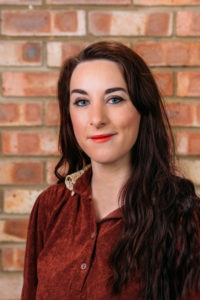
“It’s a matter of quite ferocious debate at times,” explains Ruth, on the topic of preferred nomenclature for deafness and hearing loss. “For me, it depends on what sort of mood I’m in. If I’m feeling a bit shy about it, I think ‘hearing impaired’ sounds a bit softer than ‘deaf.’ Sometimes I say ‘hard of hearing.’ That’s usually enough to tell people that you’ve got a problem hearing, that you need a bit of extra help, a bit of extra consideration.”
Learning to hear
Ruth was born profoundly deaf, meaning she has little to no residual hearing. Many people who are born deaf learn to communicate using sign language, such as British or American Sign Language, as their first language, and they identify with the Deaf community (spelled with a capital D in this case so as to refer to the Deaf community as opposed to the hearing condition). Ruth’s parents had been open to her learning sign language, but they were concerned that she’d depend on it completely. Instead, they were hoping for her to make the most of what little hearing she had and for her to try the latest hearing technologies. Powerful hearing aids gave Ruth some hearing, and with the support of a speech and language therapist, she learned to speak.
When she was 13, Ruth had a cochlear implant fitted, which she found to be transformative. A cochlear implant is an electronic device that replaces the function of the damaged inner ear. Unlike hearing aids, which make sounds louder, cochlear implants replicate hearing by electrically stimulating the auditory nerves of the inner ear. Ruth’s cochlear implant made a tremendous difference to her hearing, and when she was 23, she had a second one fitted. The combination of cochlear implants and hearing aids gave Ruth—who’s now 30—what she describes as “pretty reasonable hearing.”
Although Ruth now has access to a variety of sounds, her hearing loss still affects her day-to-day life. She cites an example of working in a busy open-plan office, where spontaneous and informal conversations often spring up: “A lot of information is shared by accident. I’m aware I miss all that and it feels like a shame. People need to be aware of that, and if there’s something important, they should try and draw you in, but it’s impossible to do that all the time. Accessibility is often built around structures and planning, isn’t it? So I think ‘unplanned accessibility’ is a really hard thing.”
Structuring the web
A similar lack of structure and planning among many developers hinders Ruth’s ability to use the web. The growing number of videos shared online, particularly through live-streaming platforms, such as Facebook Live or Periscope, are seldom subtitled. Subtitles (called closed captions in the United States and Canada) are words shown at the bottom of videos to explain what is being said or happening. “If subtitles aren’t possible, then at least provide a description of what the video is about,” appeals Ruth. “That’s increasingly missing as people get more casual about posting content.” She recalls a video of Aretha Franklin that a friend shared on Facebook: “I see her playing the piano and I think, ‘What song is she playing? There’s absolutely no description. It’s not that I need to hear every word, but sometimes I have no idea what’s happening.”
For deaf and hard of hearing people, who rely heavily on visual information, Ruth can’t overstate the importance of structured content, such as headings, paragraphs, and lists. “It makes a big difference because if you’re lacking in one sense, you make up for it with other senses.” Well-structured information helps people decide whether to engage with content, and it can help stem information overload. “If you can’t make informed choices about what you pay attention to, you can get lost very quickly,” warns Ruth. “If I find a website that’s poorly structured—bad headings, bad layout, maybe too much on one page—I find that very hard to cope with.”
My next post shares some of the things that make life easier for Ruth on the web, and we offer some practical guidance on how to improve accessibility for deaf and hard of hearing people.
Ruth is the copyright and licences officer at York St. John University in the UK, where she specialises in the legal aspects of information management. She blogs at librarianinlawland.com, and she tweets at @thehearinglib.

Comments
I recently worked with a charity who were planning to have their key information & contact pages translated into BSL. Previous to that this was not an area of accessability I was aware of, and so it is interesting to hear a real example of how deafness can affect the usability of the web.
When we came to embedding these translations (videos) we realised there was little in the way of best-practice for BSL translations, so it would be interesting to hear if anyone has seen this in the wild, and how best to present them to deaf users.
Thanks for your comment, Bradley. That’s great to hear and exactly what we hoped to achieve with this blog post.
As for examples of sign language translations “in the wild”, I’m only aware of a few (random) websites that provide it. These mainly relate to e-governance (such as the website of Camden Council in London) and digital culture (such as the UK’s Historic Royal Palaces website). I can’t comment on the quality of these examples though. Perhaps others could provide some more suggestions?
Hi! When are you going to write part two?
Hi Joe. The follow-up post should be up in the next couple of weeks.